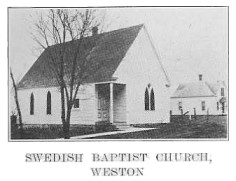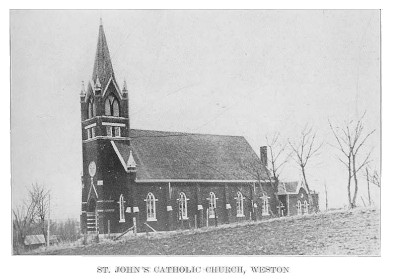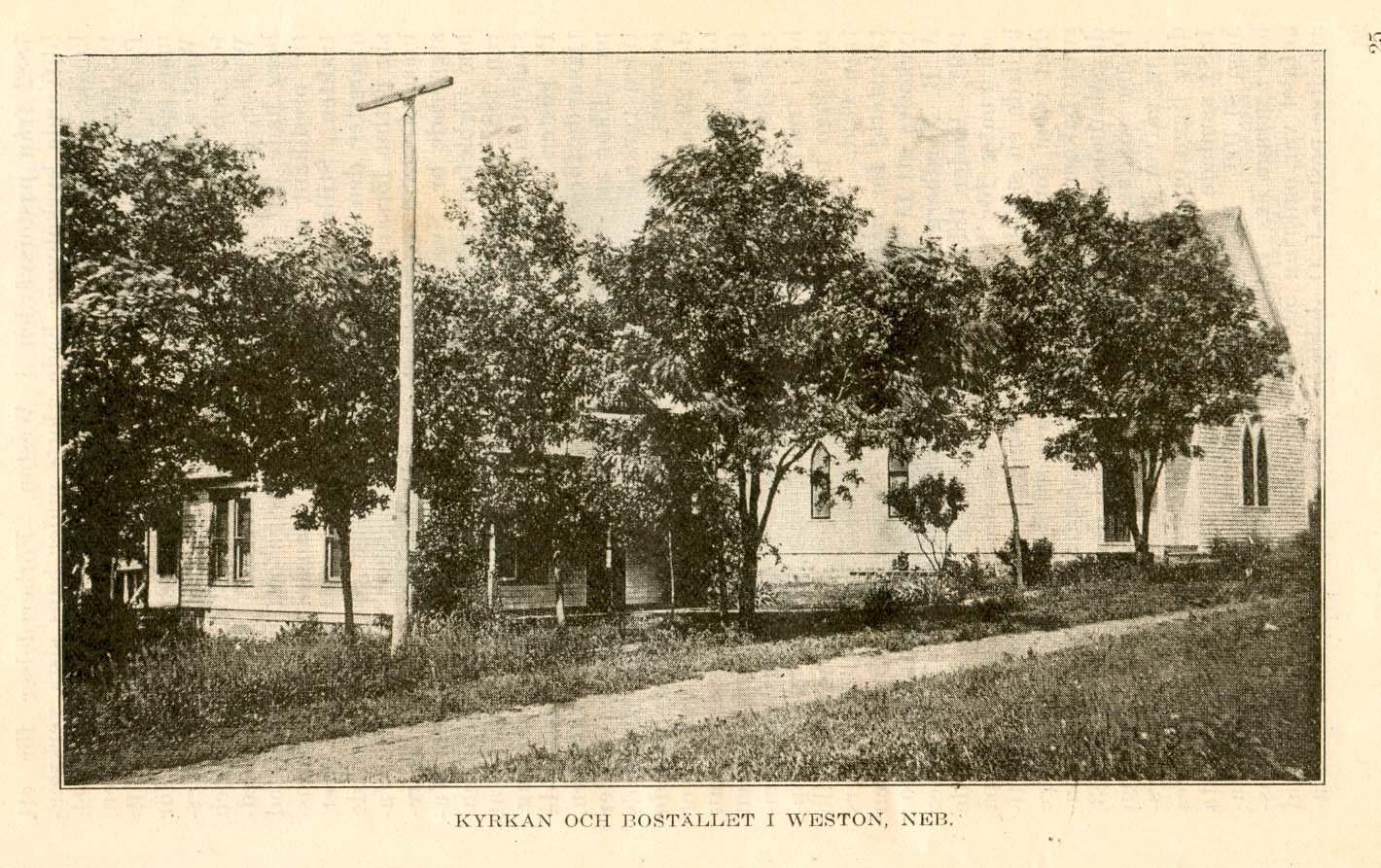The Weston Survivor: Second Swedish Baptist Church of Saunders County
"Full many a gem of purest ray serene

the deep, unfathomed caves of ocean bear.
Full many a flower is born to bloom unseen,
and waste its fragrance on the desert air"

The church in its earlier form
In Saunders County, the Mead church flourished while Estina languished. In Oakland and Stromsburg strong Swedish Baptist churches thrived along railroad lines. Their counterparts at Argo and Salem "eight miles northwest" of Stromsburg are all but forgotten. None pressed further than the Baptists, witness the churches of Gary, Balsora, or Dry Valley in western Nebraska. Weston is somewhat different, for it was not passed by when the railroads came. In that regard it was more fortunate than its neighbor, Estina. It was also located within the town itself rather than out in the country. It's particular burden was its minority ethnic status. The stately St. Johns Catholic church was the pride of the community's dominant ethnic group, more Balkan than Baltic. With the propensity of Swedes to band together, it is somewhat of a surprise to find a Swedish church in Weston.

no Lutheran competition in Weston, but...
In the days when it was significant to record such things, the place of origin of most Weston Swedes was Göttland. The Olof Nelsons and Jakob Ockanders are mentioned. But some were from Dalarna, including W. Cedargren and John Bruse (Bruce), descended from Scottish refugee Robert Bruce. Other Bruces were found in nearby Malmo, where they divided themselves between the Lutheran and Mission congregations. The argument that ethnicity trumped denomination among the immigrants may be advanced by the example of Bruce joining the Weston Baptists, just as in Council Bluffs where Imanuel Augustana's ranks swelled with the closing of the Swedish Baptist church. Here it may be noted that all immigrant Swedish Baptists in these days were born, baptized and confirmed in the Lutheran church...by law. There must have been a lot of Lutheran tint to the color in their veins, in spite of their bad treatment. They were no more enamoured of the ways of American Baptists than their Lutheran brethren were of American Lutherans, and it would probably be a mistake to equate their ethos with that of Baptists generally.

First pastor, N. Hayland
Perhaps the wonder of a Weston can be attributed to the quality of its founders. Rev. N. Hayland was not only among the most revered of the early immigrant Baptist ministers; he was in fact the very first to be graduated from Capt. Edgren's seminary in Chicago. An observation of one historian suggested Hayland could both preach like Moody and sing like Sankey! This points to the influence of the Chicago evangelist in Swedish Baptist circles. David M. Gustafson has argued convincingly of the similar Moody influence among the Free Mission people. Serving Estina and Weston in their earliest times, Hayland went on to the Omaha; Portland, Oregon; and finally Los Angeles, California churches. And at the charter meeting, the secretary was none other than Estina's most famous son, Fredrik Franson. An indication of Weston's relationship to Estina is seen in the formal title of the group: "The Second Swedish Baptist Church of Saunders County." There is some evidence that it was initially located outside the town itself. With Hayland at the helm Weston took second place to none, but the future was less bright. The parsonage was often empty. Betsy Anderson, an evangelist who we believe had a homestead at Swede Bend, Iowa, conducted revival meetings at Weston which added significantly to the membership there. When the Swedish Central Baptist Seminary was located in Stromsburg, the student Herman Bergman served the Weston congregation briefly. He would later be pastor in Arthur, Iowa, figuring in the story of descendant Lorraine Anderson Lovain's story "Swedish Roots." Other students mentioned are August Olson and David Oberg. Nebraska missionary K.S. Swedberg had responsibility for Weston, Estina and Wahoo following Hayland's departure. At this time, the congregation extended a call for Hayland to return to his earlier charge, and were surprised and excited when he accepted. Alas, less than two years later the irresistable opportunity to go to Los Angeles deflated their plans. It was apparently in 1893 during the pastorate of A.B. Nordberg that the church building we picture was built.

Weston Baptist near the summer of its years, 1919
L. Johanson later preached there "as often as he could", and N.S. Miller combined duties with the Wahoo church while a student at Luther College! This would seem an unlikely combination. C.J. Johnson conducted services at Weston and at the English Baptist church in Wahoo, signalling the day soon to come when Weston affiliated with the American Baptists. The Americans had resources beyond the means of the Swedes and sometimes outweighed even the ethnic preferences. The entire Kansas conference reportedly chose this alternative to the Swedish conference.

St. Johns remains impressive today